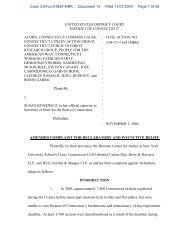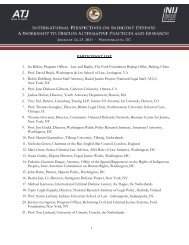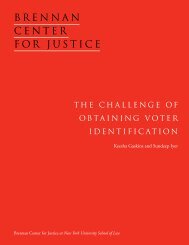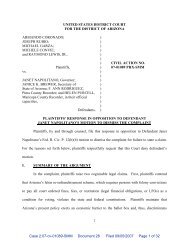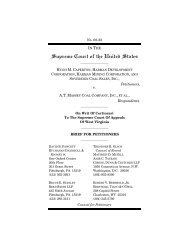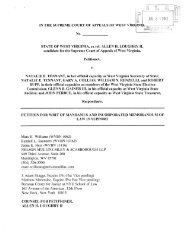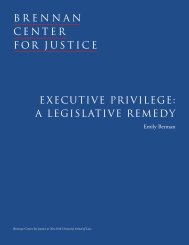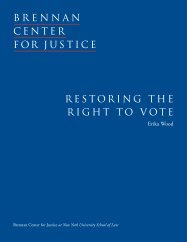THE NEW YORK STATE LEGISLATIVE PROCESS: AN ...
THE NEW YORK STATE LEGISLATIVE PROCESS: AN ...
THE NEW YORK STATE LEGISLATIVE PROCESS: AN ...
You also want an ePaper? Increase the reach of your titles
YUMPU automatically turns print PDFs into web optimized ePapers that Google loves.
58 <strong>THE</strong> <strong>NEW</strong> <strong>YORK</strong> <strong>STATE</strong> <strong>LEGISLATIVE</strong> <strong>PROCESS</strong>: <strong>AN</strong> EVALUATION <strong>AN</strong>D BLUEPRINT FOR REFORM<br />
IN ALB<strong>AN</strong>Y THROUGH RULES REFORM (Oct. 2002) (on file with the Brennan Center).<br />
10 Every year, the editors of McKinney’s Session Law News of New York identify and publish a list<br />
of those laws enacted in the prior year and determined to be “major legislation.” For the purposes<br />
of this study, we have analyzed the “major legislation” passed from 1997 through 2001. See<br />
MCKINNEY’S SESSION LAW <strong>NEW</strong>S OF <strong>NEW</strong> <strong>YORK</strong> (1997-2001). For a list of these laws, see Appendix<br />
A [hereinafter MAJOR LEGISLATION <strong>AN</strong>ALYSIS 1997-2001]. Although 310 laws were identified by<br />
McKinney’s, two of those laws (S70001 and S70002) were not listed in the Legislative Digest for<br />
the years in question. Accordingly, we did not include those two laws in our analysis of major legislation.<br />
11 To obtain information concerning committees’ handling of each of the “major” laws<br />
passed from 1997 through 2001, we examined committee voting records from the Assembly Public<br />
Information Office and the Senate Journal Clerk’s Office for all of the committees through which<br />
these bills passed. Those records reflect both attendance at those meetings at which the bills were<br />
voted out of committee and the vote tallies for each bill. Because the Senate permits proxy voting<br />
in committee, however, those records do not reflect actual attendance at any meeting. In addition,<br />
neither the Public Information Office nor the Journal Clerk’s Office nor the committees themselves<br />
maintain any publicly available minutes of committee meetings. As a result, it is impossible without<br />
testimonial evidence to determine whether or how the committee addressed a specific bill during<br />
a committee meeting unless a vote on the bill occurred at that meeting. Similarly, records of<br />
committee hearings and reports, to the extent these are available, are not maintained in a central<br />
location. To supplement the committee voting records, therefore, where possible we interviewed<br />
both the legislative analysts from each of the relevant committees and staff members for the laws’<br />
sponsors to determine whether public hearings had been held and whether committee reports had<br />
been issued on the bills in question [hereinafter MAJOR LEGISLATION COMMITTEE <strong>AN</strong>ALYSIS].<br />
12 Information on debate was collected from the floor transcripts for the day of each bill’s passage,<br />
maintained by the Senate Microfilm/Microfiche Office and the Assembly Office of Public<br />
Information. The transcripts for the days on which each of the bills deemed “major legislation” by<br />
McKinney’s from 1997 through 2001were reviewed. Information on the message of necessity for<br />
the same bills was collected from the Legislative Bill Drafting Commission, <strong>STATE</strong> OF <strong>NEW</strong> <strong>YORK</strong><br />
<strong>LEGISLATIVE</strong> DIGEST (1997-2001).<br />
13 To complete this analysis, we examined the voting records of the Committee on Economic<br />
Development for the years 1997-2001 obtained from the Assembly Public Information Office.<br />
[hereinafter COMMITTEE ON ECONOMIC DEVELOPMENT <strong>AN</strong>ALYSIS].<br />
14 This historical survey covered specific legislative procedures and practices from 1777 to the<br />
present, but focused on the period since 1900. Sources included proceedings of the constitutional<br />
conventions, contemporary press accounts, contemporary studies of the New York State legislature<br />
and commission reports, secondary historical works on New York history, and political science literature<br />
on legislative procedure.<br />
15 Using the most recent versions of state legislative rules available on-line, we analyzed their<br />
treatment of specific steps in the legislative process, including limitations on debate, discharge of<br />
bills from committee, committee hearings, voting, and Rules Committees. [hereinafter RULES<br />
<strong>AN</strong>ALYSIS].<br />
16 Interviews were conducted by telephone with the offices listed in Appendix B. A copy of<br />
the questionnaire is also included therein. Through this survey, we obtained complete information<br />
concerning 94 of the 97 state legislative chambers outside New York. [hereinafter NATIONAL<br />
TELEPHONE SURVEY].<br />
17 Professional legislatures (California, Illinois, Massachusetts, Michigan, New Jersey, New<br />
York, Ohio, Pennsylvania, and Wisconsin) are defined through an index of legislative professionalism<br />
presented in SARAH MCCALLY MOREHOUSE & MALCOLM E. JEWELL,<strong>STATE</strong> POLITICS,PARTIES,<br />
<strong>AN</strong>D POLICY 212-13 (2d ed. 2003). The use of this cohort as a benchmark against which to assess



